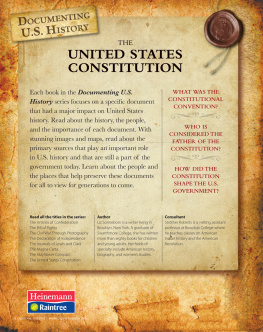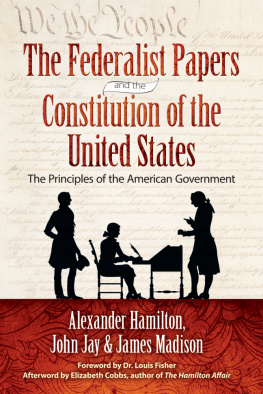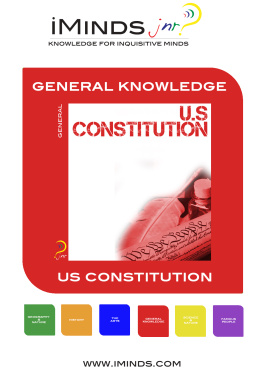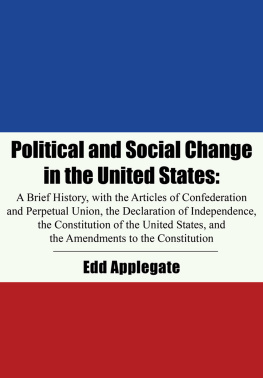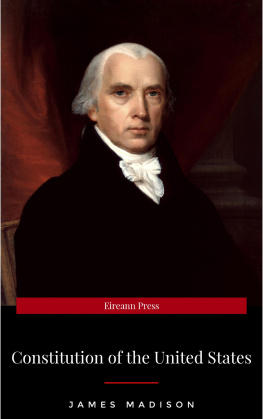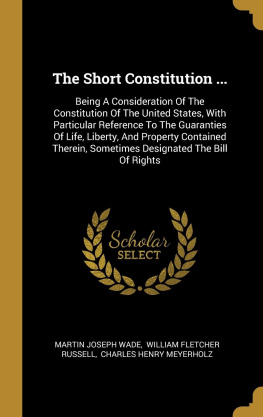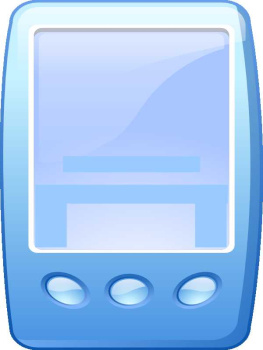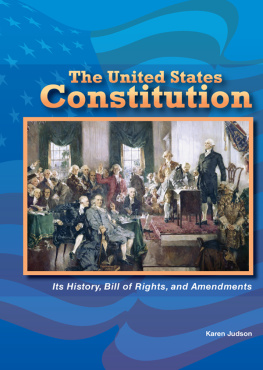Liz Sonneborn - The United States Constitution
Here you can read online Liz Sonneborn - The United States Constitution full text of the book (entire story) in english for free. Download pdf and epub, get meaning, cover and reviews about this ebook. year: 2012, publisher: Capstone, genre: Politics. Description of the work, (preface) as well as reviews are available. Best literature library LitArk.com created for fans of good reading and offers a wide selection of genres:
Romance novel
Science fiction
Adventure
Detective
Science
History
Home and family
Prose
Art
Politics
Computer
Non-fiction
Religion
Business
Children
Humor
Choose a favorite category and find really read worthwhile books. Enjoy immersion in the world of imagination, feel the emotions of the characters or learn something new for yourself, make an fascinating discovery.
- Book:The United States Constitution
- Author:
- Publisher:Capstone
- Genre:
- Year:2012
- Rating:3 / 5
- Favourites:Add to favourites
- Your mark:
- 60
- 1
- 2
- 3
- 4
- 5
The United States Constitution: summary, description and annotation
We offer to read an annotation, description, summary or preface (depends on what the author of the book "The United States Constitution" wrote himself). If you haven't found the necessary information about the book — write in the comments, we will try to find it.
Learn about the United States Constitution, one of the most significant documents in U.S. history. Find out about those who were involved in its creation and why studying this primary source is so important.
The United States Constitution — read online for free the complete book (whole text) full work
Below is the text of the book, divided by pages. System saving the place of the last page read, allows you to conveniently read the book "The United States Constitution" online for free, without having to search again every time where you left off. Put a bookmark, and you can go to the page where you finished reading at any time.
Font size:
Interval:
Bookmark:

May 14, 1607
Jamestown, the rst permanent British settlement in what is now theUnited States, is founded.
December 16, 1773
American colonists protest British taxes at the Boston Tea Party.
April 19, 1775
The Revolutionary War begins with the battles of Lexington and Concord.
May 10, 1775
The Second Continental Congress rst meets.
July 4, 1776
Members of the Second Continental Congress approve the Declaration ofIndependence.
November 15, 1777
The Second Continental Congress approves the Articles of Confederation.
March 1, 1781
The Articles of Confederation go into effect.
October 19, 1781
The British army surrenders at Yorktown, Virginia.
September 3, 1783
The signing of the Treaty of Paris marks the end of the RevolutionaryWar.
September 11, 1786
State representatives meet for the Annapolis Convention.
May 14, 1787
Delegates from all the states, except for Rhode Island, gather in Philadelphiato discuss revising the Articles of Confederation.
May 25, 1787
The Philadelphia Convention (now known as the Constitutional Convention)begins.
May 29, 1787
Delegates from Virginia present the Virginia Plan to the Convention.
June 13, 1787
Convention delegates create the rst draft of the Constitution.
June 23, 1787
Convention delegates establish the Committee of Detail to revise theConstitution.
July 16, 1787
The Constitutional Convention votes to accept Roger Shermans planfor selecting members of Congress.
August 6, 1787
A Philadelphia printer prints a second draft of the Constitution.
September 8, 1787
The Committee of Style is formed to craft a nal version of theU.S. Constitution.
September 1517, 1787
Jacob Shallus produces the engrossed copy of the U.S. Constitution.
September 17, 1787
Thirty-nine members of the Constitutional Convention sign theU.S. Constitution.
September 20, 1787
The proposed Constitution is read before Congress.
October 27, 1787
The rst of the Federalist Papers appears in print.
June 21, 1788
New Hampshire becomes the ninth state to approve the U.S. Constitution.
March 4, 1789
The national government established by the U.S. Constitution ofciallybegins operating.
April 30, 1789
George Washington becomes the rst president of the United States.
December 15, 1791
The Bill of Rights is formally added to the Constitution.
1800
The Constitution is stored in Washington, D.C.
1814
James Monroe saves the Constitution by taking it out of Washington, D.C., duringthe War of 1812. It is later returned to Washington.
1924
The Constitution is put on display in the Library of Congress in Washington,D.C.
1952
The Constitution is displayed in the National Archives in Washington, D.C.
Fradin, Dennis Brindell. The Signers: The 56 Stories Behind the Declaration of Independence .New York: Walker, 2003.
Freedman, Russell. In Defense of Liberty: The Story of Americas Bill of Rights .New York: Holiday House 2003.
Ransom, Candice F. Who Wrote the U.S. Constitution? And Other Questions About theConstitutional Convention of 1787. Minneapolis, Minn.: Lerner, 2010.
Stein, R. Conrad. The National Archives . New York: Franklin Watts, 2002.
Taylor-Butler, Christine. The Constitution of the United States . New York: ChildrensPress 2008.
The Charters of Freedom: The National Archives
www.archives.gov/exhibits/charters
This website features images of various versions of the Constitution and biographies of the Founding Fathers.
Creating the United States: The Library of Congress
http://myloc.gov/Exhibitions/creatingtheus/Pages/default.aspx
Visit this website to learn how the U.S. Constitution was created.
To Form a More Perfect Union: The Library of Congress
http://memory.loc.gov/ammem/collections/continental/intro01.html
This site discusses the Constitutional Convention and the events leading up to it.
The U.S. Constitution is possibly the most important document in U.S. history. Itestablished how the government of the United States works. It also set out certainbasic rights that all U.S. citizens share.
The U.S. Constitution is an example of a primary source . Primary sources are writtenor made by someone living through a historical event. Like the Constitution, someprimary sources are ofcial documents. But more informal writings, such as diariesor letters, are also helpful to historians. By studying primary sources, historianscan create a picture of how people lived in the past.
We the People of the United States, in Order to form a more perfect Union, establishJustice, insure domestic Tranquility [peace], provide for the common defence, promotethe general Welfare, and secure the Blessings of Liberty to ourselves and our Posterity[future], do ordain and establish this Constitution for the United States of America.
from the preamble (introduction) to the U.S. Constitution

Documents, letters, diaries, and newspapers are just a few primary sources on display.
Not all primary sources are written down. Other types of primary sources includelms, audio recordings, photographs, artwork, and even everyday objects like toolsand toys. In fact, just about everything produced in an earlier time period can providea clever historian with clues about times long ago.
You might not realize it, but every day you produce primary sources. Your text messages,your Facebook posts, and even your homework reveal things about you. If you savedall of these, a future historian might study them to learn about your times.
Important primary sources that survive usually end up in an archive . An archive isa place where primary sources are collected and carefully stored. For example, theoriginal ofcial copy of the U.S. Constitution is housed in the National Archivesin Washington, D.C.
At archives, experts called archivists research the items in their collections. Bystudying and preserving primary sources, archivists ensure that future generationscan see and learn from them.
By studying primary sources, historians develop an understanding of the past. Theyoften write down their ideas about other time periods in history books and textbooks.These are examples of secondary sources .
If you want to learn about another time, it makes sense to look at both primary andsecondary sources. Each type serves a different purpose. In primary sources, peopleof another time period tell you about their lives in their own words or through theobjects they made. In this way, you can feel a connection to people of the past.You might even be able to imagine how you would feel in their place.
Recent technologies have created new types of primary sources. In the future, e-mails,computer les, and digital photographs will be among the things historians look atto learn about how we lived.
Secondary sources, on the other hand, help you see the big picture. By telling youthe complete history of the time period, they can help you make sense of primarydocuments.
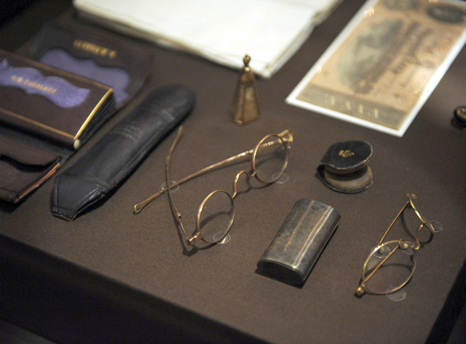
Font size:
Interval:
Bookmark:
Similar books «The United States Constitution»
Look at similar books to The United States Constitution. We have selected literature similar in name and meaning in the hope of providing readers with more options to find new, interesting, not yet read works.
Discussion, reviews of the book The United States Constitution and just readers' own opinions. Leave your comments, write what you think about the work, its meaning or the main characters. Specify what exactly you liked and what you didn't like, and why you think so.

